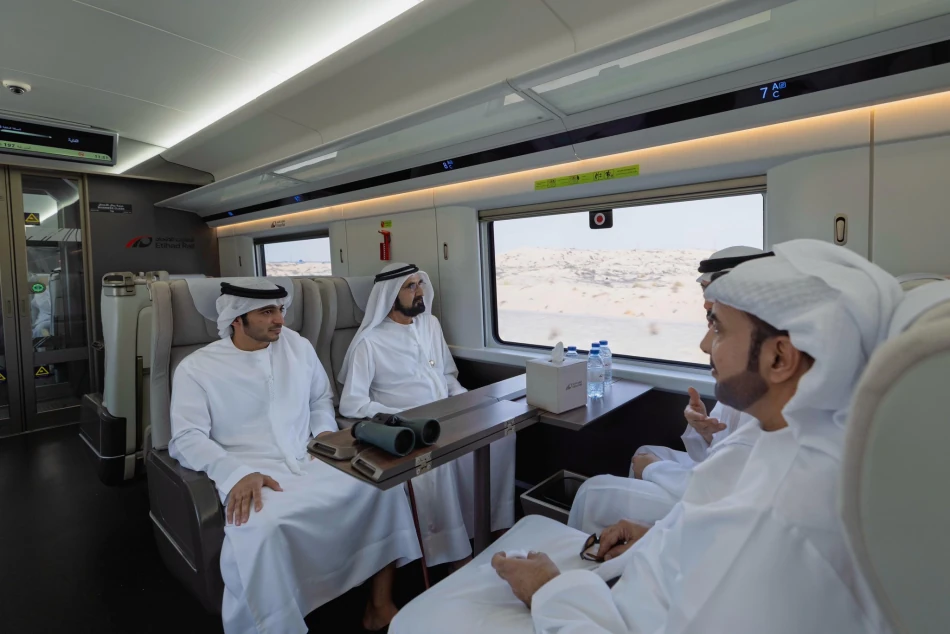
Dubai's Ruler Praises Nation's Ambitious Railway Projects and Tireless Workforce
UAE's $50 Billion Rail Vision Takes Shape as Sheikh Mohammed Rides Dubai-Fujairah Route
The UAE's ambitious national railway project moved closer to reality as Vice President Sheikh Mohammed bin Rashid Al Maktoum took a test journey on the Union Railway connecting Dubai to Fujairah. The high-speed rail network, set to launch next year, represents one of the Gulf's most significant infrastructure investments and could reshape regional logistics while positioning the Emirates as a continental transit hub.
A 200 km/h Network Connecting 11 Cities
Sheikh Mohammed's social media post revealed key details about the Union Railway's scope and ambitions. The network will connect 11 cities and regions across the UAE at speeds of 200 kilometers per hour, with projections to transport 36 million passengers annually by 2030.
The Dubai-Fujairah route holds particular strategic importance, linking the UAE's commercial capital with its key eastern port on the Indian Ocean. This connection bypasses the Strait of Hormuz chokepoint, offering an alternative shipping route that could prove crucial during regional tensions.
Beyond Passengers: A Freight Revolution
While passenger numbers grab headlines, the railway's freight capacity may deliver greater economic impact. The system will handle both passengers and cargo, potentially transforming the UAE into a land bridge between Asia and Europe. Current shipping routes through the Suez Canal face increasing congestion and security concerns, making overland alternatives increasingly attractive to global logistics companies.
Regional Competition Heats Up
The UAE's rail ambitions arrive amid fierce Gulf competition for logistics supremacy. Saudi Arabia's NEOM project includes plans for a futuristic linear city connected by high-speed rail, while Qatar expanded its metro system ahead of the 2022 World Cup. However, the UAE's approach focuses on practical connectivity rather than experimental urban planning.
The timing also reflects lessons learned from China's Belt and Road Initiative, where rail connections have proven more reliable than initially skeptical observers predicted. The UAE appears to be positioning itself as a western terminus for potential future rail links extending toward Europe through Turkey.
Investment and Economic Impact
The Union Railway represents part of the UAE's broader infrastructure spending strategy, designed to reduce oil dependency while creating new revenue streams. The project's leadership under Dhiyab bin Mohammed bin Zayed, a member of Abu Dhabi's ruling family, signals high-level political commitment that typically ensures project completion in the Emirates.
For investors, the railway's 2025 launch timeline appears realistic given the UAE's track record of delivering major infrastructure projects on schedule. The Dubai Metro opened on time in 2009, and Dubai International Airport's expansions have consistently met deadlines.
Strategic Implications for Global Trade
The railway's completion could significantly impact global shipping patterns, particularly for goods moving between Asia and Europe. Current sea routes take approximately 15-20 days from major Asian ports to European destinations via the Suez Canal. A rail connection through the UAE could potentially reduce transit times while offering greater schedule reliability.
The project also strengthens the UAE's position as regional tensions periodically threaten traditional shipping lanes. Iran has repeatedly threatened to close the Strait of Hormuz during conflicts, making alternative routes increasingly valuable to international trade.
Sheikh Mohammed's emphasis on continuous infrastructure development reflects the UAE's broader strategy of building competitive advantages through connectivity. As global supply chains face increasing disruption, countries offering reliable alternative routes stand to capture significant economic benefits from the shifting logistics landscape.
Most Viewed News

 Sara Khaled
Sara Khaled






